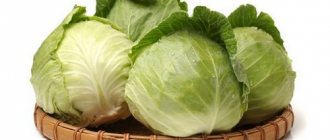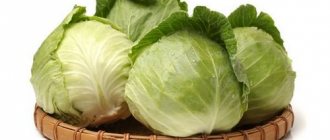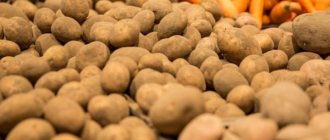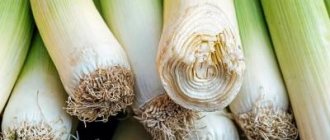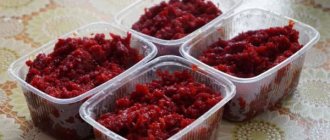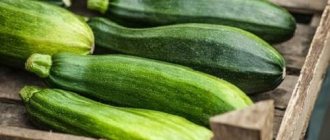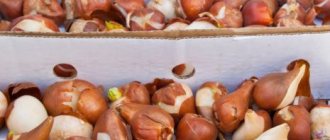Preparing cabbage for storage
Competent and high-quality storage of the crop directly depends on compliance with all stages of agricultural technology, timely and correct harvesting, as well as on preparing cabbage for the winter.
Vegetables should be harvested at the end of autumn, when the first night frosts begin and temperatures drop below zero. You should not harvest cabbage too early, because unripe heads of cabbage then quickly wither and are poorly stored.
But there is also no need to delay collection, because severe frosts cause the heads to crack and lose their consumer qualities.
Cabbage harvesting is carried out using the following technology:
- Work is carried out in clear and dry weather. Otherwise, the crop will have to be dried additionally.
- Using a shovel, the heads of cabbage are dug up along with the root. Clods of earth are carefully shaken off.
- The covering leaves are removed from the forks, leaving no more than 2-3 to protect them from possible damage.
- Then the crop is carefully inspected and sorted. Broken, cracked, pest-damaged, frozen and too loose specimens are rejected. They can be eaten immediately or processed for winter storage (fermented).
- The remaining heads of cabbage should be clean, strong and firm, with no signs of damage.
- It is necessary to trim the roots with a sharp knife, leaving a stalk about 2-3 cm long. Sometimes the forks are left with the roots for the winter, it all depends on the storage method.
- Then it is advised to dry the vegetables under a canopy or in a cool room for 1-2 days and only then put the cabbage in the cellar for the winter.
Proper harvesting of cabbage for storage
To preserve the heads for a long time, they must be collected correctly from the beds. Vegetables begin to be harvested during the first frost. The heads hardened in this way will be even tastier and healthier. Heads of cabbage harvested earlier first begin to wither and then crack.
For cleaning you will need a shovel and a garden knife or ax. First of all, we dig the plant from the ground without cutting off the stalks. Clear the roots from the soil and leave a few cover sheets. Next, the heads of cabbage are dried in the shade for 5 hours.
Note: If you dry cabbage in the open sun, it will quickly lose moisture and begin to wilt.
If the weather was dry before harvesting, the heads do not need to be dried further. Since cabbage with or without roots is suitable for storage, removal of the root system is carried out at will. If you prefer not to cut the roots, the heads of cabbage can be left hanging in the cellar. With this placement, the heads do not touch each other, are well ventilated and, accordingly, are less susceptible to rotting. If you are going to cut the roots, then on each head you need to leave a stalk 4 cm long.
How do cabbage varieties affect its storage?
Not all varieties of cabbage store equally well in winter. Which variety is stored for winter will determine the safety of the crop without loss of taste and consumer qualities.
Early ripening varieties are salad varieties; they have juicy, tender and tasty leaves. But they are completely unsuitable for long-term maintenance, because they quickly deteriorate. They can be kept in the refrigerator for no more than 2 weeks.
Mid-season varieties can last for about 2-3 months. They are also put into storage, but they try to use them first. Heads of cabbage of later ripening have many hard veins on the leaves, and such vegetables are less juicy.
But they have the ability to improve their taste when they lie in the cellar in winter.
Important! Mid-late and late varieties with a long growing season (3-4 months) are suitable for long-term storage.
Their shelf life can reach up to 6-8 months or more.
Popular varieties of cabbage for long-term storage
The most common and popular varieties of cabbage, most suitable for long-term winter storage, are:
- Wintering. The fruits weigh about 3 kg and have good shelf life (from 3 to 6 months).
- Valentina F1. Strong, dense heads, weighing from 3 to 5 kg, can be stored for more than 9 months.
- Amager G1. Dense heads of cabbage weighing about 4 kg are stored for about 8 months. Moreover, over time the taste improves.
- Stone head. Round, extremely dense forks, weighing up to 4 kg, can be stored for more than 8 months.
- Moscow late. Large heads of cabbage, sometimes weighing more than 8 kg, last up to 8 months.
- Aggressor F1. Hybrid white cabbage with a weight of up to 5 kg and a shelf life of 8-9 months.
- Crewmont F1. Small heads of cabbage, rarely weighing more than 2 kg, last well until March.
A large number of varieties and hybrids of cabbage that can be placed in a cellar or basement for winter storage have been developed. They differ in taste and shelf life. It is recommended to use several varieties with different shelf life at the same time.
If vegetables are purchased at the market or in a store, when it is impossible to determine their varietal identity, you should focus on the appearance of the heads of cabbage.
A good fork, suitable for winter storage, should be hard, dense, not very large and have a slightly flattened shape. The color of such heads of cabbage is light, sometimes almost white. Early ripening varieties are always darker shades of green.
Best varieties for storage
Not all types of vegetables can last until spring. You should carefully study the varieties of cabbage for storage in the cellar. Thus, early types are intended for quick consumption. They are ready for use from the beginning of summer. Late white cabbage and cauliflower have hard leaves that remain juicy until spring.
If the question arises of how to keep cabbage fresh in the cellar for the winter, then attention should be paid to the Zimovka variety. The heads do not lose their properties for 7 months. In the same way, you can keep broccoli for the winter at home. Agro offers a wide range of Beijing and white cabbage seeds. The following varieties can be stored in the basement:
- Kolobok;
- Monomakh;
- Crewmont;
- Hybrids Marathon, Lennox, Bartolo;
- Hybrids with a short growing season Eaton and Hurricane;
- Present.
All cabbage should be kept in the cellar in winter. It is necessary to choose dense heads of cabbage, the weight of which is from 3 kg.
In this video we will look at ways to store cabbage:
Storage rules
To understand how to store cabbage in the cellar in winter, you need to find out what other preparatory measures need to be taken so that the crop remains fresh longer without losing vitamins and beneficial properties.
Proper storage of vegetables includes not only the correct collection and preparation of the crop for storage for the winter, but also the appropriate preparation of the storage itself.
Storing cabbage in a cellar, underground or basement will be successful and long enough only if certain requirements are met.
The cellar should be cleared in advance of the remnants of last year's harvest, the walls should be whitewashed with lime and fumigated with special smoke bombs to destroy bacterial infection and mold.
All internal structures (racks, boxes, etc.) also require disinfection; they are treated with special compounds (copper sulfate, Bordeaux mixture). If necessary, measures should be taken to protect against rodents and insect pests.
Cabbage in the cellar should remain sorted into varieties until spring, since their shelf life is different and each type requires its own conditions of maintenance. You shouldn’t put all the heads of cabbage mixed up.
Rotten forks of earlier ripening can infect neighboring heads of cabbage, which can lie in the basement in the winter much longer. This could result in the loss of the entire crop.
Terms and Conditions
How to store cabbage in the basement in winter? Despite the strict conditions , it is possible to preserve cabbage in the cellar. The main thing is to choose the right variety, the right cellar and comply with all the conditions.
Early cabbage , ripening in early to mid-summer, is not suitable for winter storage.
In order for cabbage to lie in the cellar for a long time and successfully, you need to choose late-ripening varieties . They ripen only towards the end of summer - beginning of autumn.
The best cabbage varieties for storage:
- Moscow late;
- Wintering;
- Amager;
- Valentina;
- Orbit;
- Glory;
- Turkiz.
These are late-ripening and mid-ripening varieties of cabbage. Their ability for long-term storage has been tested by many gardeners. How to store cabbage in the cellar in winter?
The stated shelf life of suitable varieties in the cellar is from 3 to 4 months . If you follow all the recommendations, cabbage can last a little longer.
Cabbage storage conditions
An important condition for good preservation of the crop is the creation of the necessary microclimate in the cellar. The main requirements for conditions of detention are as follows:
- The temperature should be within -1…+2°C. At temperatures below -2°C, cabbage begins to freeze and greatly loses its consumer qualities. If the indicators remain above +4°C, then the heads of cabbage wither and become flabby. In this case, the growth of the apical bud may begin. Such a vegetable becomes unsuitable for food.
- Optimal air humidity should range around 85-95%. Cabbage loves moist air, but the room should not be too damp, as this promotes rotting. In an overly dry cellar, vegetables dry out and begin to sprout, and the taste deteriorates greatly.
- In the basement, subfloor or cellar you need to ensure good ventilation. If there is none, then the room needs to be ventilated periodically.
Storage Features
A special feature of keeping cabbage in winter is that these vegetables emit heat and carbon dioxide during the entire storage period. If there are a lot of vegetables, they can greatly influence the humidity and temperature in the cellar.
But they are stored under fairly strict temperature and humidity conditions. Even small changes in living conditions lead to the loss of cabbage and table qualities. In order for them to last longer, you need to try to strictly follow all storage recommendations.
You need to put the cabbage in the basement prepared, carefully sorted and without the slightest damage. The place for storing cabbage should be disinfected in advance so as not to provoke the development of infection.
At least once every 20-30 days, the entire crop should be carefully inspected and rotten specimens should be discarded.
Important! At the slightest sign of a fungal disease, a suspicious head of cabbage must be immediately removed from storage, as the spores spread quickly.
Cabbage easily tolerates proximity to other vegetable crops and root crops. It can be kept in the same room with potatoes, beets, turnips, carrots, etc. But due to the fact that it loves humidity, it is recommended to place the forks as far as possible from other vegetables. Any infection can quickly spread to the heads of cabbage.
How to store cabbage in the cellar for the winter
The heads of cabbage should be placed in the cellar so that they do not touch each other. The best option is to hang the forks by the stalk from the ceiling.
In addition, the following methods are practiced:
- wrapping heads of cabbage in cling film;
- storing fruits in plastic bags;
- wrapping forks in food paper, which allows them to be put in boxes;
- coating the heads of cabbage with a layer of clay, which guarantees their excellent preservation.
Shelf life
What types of heads of cabbage and how long can be stored in the cellar have already been discussed above. On average, the shelf life of cabbage forks ranges between 3 and 6 months. White cabbage hybrids demonstrate particularly good keeping quality and most often last for more than six months.
Optimal conditions
Trying to preserve late cabbage as best as possible until the new harvest, you should create the most favorable conditions for it in the cellar. They consist in the optimal temperature, which lies between –0.8 ° C and + 2 ° C, and humidity at 97%. A lower temperature can lead to freezing of the forks, and at a higher temperature, putrefactive processes in the heads of cabbage can begin.
Also read about how to store sauerkraut at home.
In addition, the correct gas composition of the air in the cellar, which is regulated by ventilation, is important. The storage atmosphere should contain up to 8% oxygen and no more than 3% carbon dioxide.
What vegetables can be stored nearby?
Usually in the same cellar with cabbage you can find:
- potato;
- beets;
- pumpkin;
- carrot;
- zucchini.
Cabbage can get along with all these vegetables, but experts recommend keeping them as far away from cabbage forks as possible, which will contribute to their better preservation. And in this regard, hanging cabbage heads from the ceiling is ideal for maintaining distance between them and other vegetables.
Important! Under no circumstances should you mix cabbage forks with potatoes, beets or other root vegetables in the same box.
Methods for storing cabbage
There are a fairly large number of ways to store cabbage in a cellar or basement. Each of them has advantages and disadvantages. It all depends on the conditions of detention that exist in the storage facility.
The most common method is considered to be a pyramid of vegetables. In the cellar, a wooden flooring is constructed from loosely fitted boards (they are bunched together with a gap), on which the largest and strongest heads of cabbage are laid, stalks up.
Then the next cabbage layer is placed in a checkerboard pattern, etc. The last upper tier should contain forks of poorer quality (loose and small), which are eaten first. They are laid with the stalks down.
Important! Air should pass freely between the heads of cabbage, and the entire pyramid of cabbage should be well ventilated.
In boxes
Vegetables can simply be freely placed on shelves or placed in boxes. The simplest option for preserving the cabbage harvest is to place the vegetables in lattice wooden boxes. First, each vegetable must be completely cut off the stalk and damaged upper leaves.
The forks are laid out in 1 layer at a short distance from each other. It is necessary to ensure that they do not touch. After some time, the vegetables will begin to rot at the point of contact.
Then the boxes are placed either on shelves or on stands (wooden pallet, bars, etc.) in 1 row. This will allow air to circulate well through the bottom and side lattice walls of the container. There is no need to cover the boxes with anything, because air should flow freely. This method is not considered the most effective, but it is simple and has its admirers.
In sand
When choosing the best way to store cabbage in the winter, you should pay attention to the method of keeping it in sand. Clean, washed river sand is used, which is recommended to be pre-disinfected (calcined).
A layer of sand of at least 5-10 cm is poured onto the bottom of a large box or box, then the heads of cabbage are laid out (they should not touch). The forks are completely filled with sand, then the cabbage is placed again, and so on until the container is completely filled. The last top layer is made of sand, and it should completely cover the vegetables.
With this storage method, it is possible to preserve the entire set of vitamins and microelements contained in cabbage. But this type is quite labor-intensive, because you need a lot of sand. And the technology itself is not clean.
If a box of the required size is not available, then a thick sand cushion is placed directly on the floor of the basement or cellar. Heads of cabbage are placed on it, which are then sprinkled with sand, etc. The main disadvantage of the method is that the vegetables cannot be removed and sorted.
There is another version of this method. The trick is that you don’t have to completely cover the cabbage with sand. Stumps 8-10 cm long are left on the forks. The heads of cabbage are simply stuck into the sand with the stalk down for its entire length.
A new way to store cabbage
An extremely effective and relatively recently invented method is to store cabbage in cling film. The stalk and surface leaves are cut off from the head of cabbage, leaving only the tightly adjacent ones.
Then the forks need to be wrapped in cling film in 3-4 layers, completely covering all areas. Packed vegetables are placed in bags, boxes or on shelves. From time to time (at least once a month), the crop should be inspected for the appearance of rot and spoiled specimens should be removed from the cellar. Cabbage in film can remain fresh for up to 12 months.
Sometimes cabbage is hung from the ceiling using ropes. There is no need to trim the roots, just clean them well of any remaining soil. A special structure is constructed on the ceiling in the form of beams with hooks on which cabbage can be hung.
The forks should not touch walls, shelves or each other. The disadvantage of this method is that it will not be possible to preserve many vegetables this way, since the heads of cabbage take up quite a large amount of space.
Vegetables can be wrapped in several layers of paper. It is allowed to use old newspapers. But due to the fact that printing ink contains lead, it is better to make the first layer of plain white writing paper.
Then the wrapped forks are placed on a rack or in boxes. The paper protects the vegetables, prevents them from contacting each other and absorbs excess moisture.
The old method of storing cabbage in clay is still used. To do this, each head of cabbage is thickly coated with liquid clay of a creamy consistency so that all the leaves are covered with it.
After the clay shell has completely dried, the forks are carefully placed on the shelves. With this method, vegetables do not lose moisture and retain their consumer and nutritional qualities throughout the entire storage period.
Step by step instructions
Storing cabbage in a garage pit:
- Harvest cabbage.
- Trim the stems, leaving only the heads.
- Dry if necessary and treat to remove unsuitable leaves.
- Wrap each head of cabbage in cling film.
- Place it in the garage pit.
Storing cabbage in a caisson:
- Harvest cabbage.
- Trim the stems, leaving only the heads.
- Peel off the topmost layer of leaves.
- Place in wooden boxes.
- Sprinkle with sand if possible.
- Place the boxes on the floor of the caisson.
To store cabbage in cling film you need:
- Dry the collected heads of cabbage if necessary.
- Peel the top one layer of leaves.
- Wrap each head of cabbage with several layers of film.
- Place in any convenient container or on shelves.
Storing cabbage with roots:
- Dig up the cabbage by the roots.
- Tie a rope to each head of cabbage by the leg.
- Hang the heads of cabbage from the ceiling of the cellar using it.
How to hang cabbage with roots - photo:
Storing cabbage heads:
- Harvest cabbage.
- Remove the stems, leaving only the heads.
- Remove the top layer of leaves.
- Place the heads of cabbage in boxes, on shelves or in a pyramid, and wrap in film if desired.
You will learn how to store cabbage in the cellar using a vacuum cleaner by watching the video:
